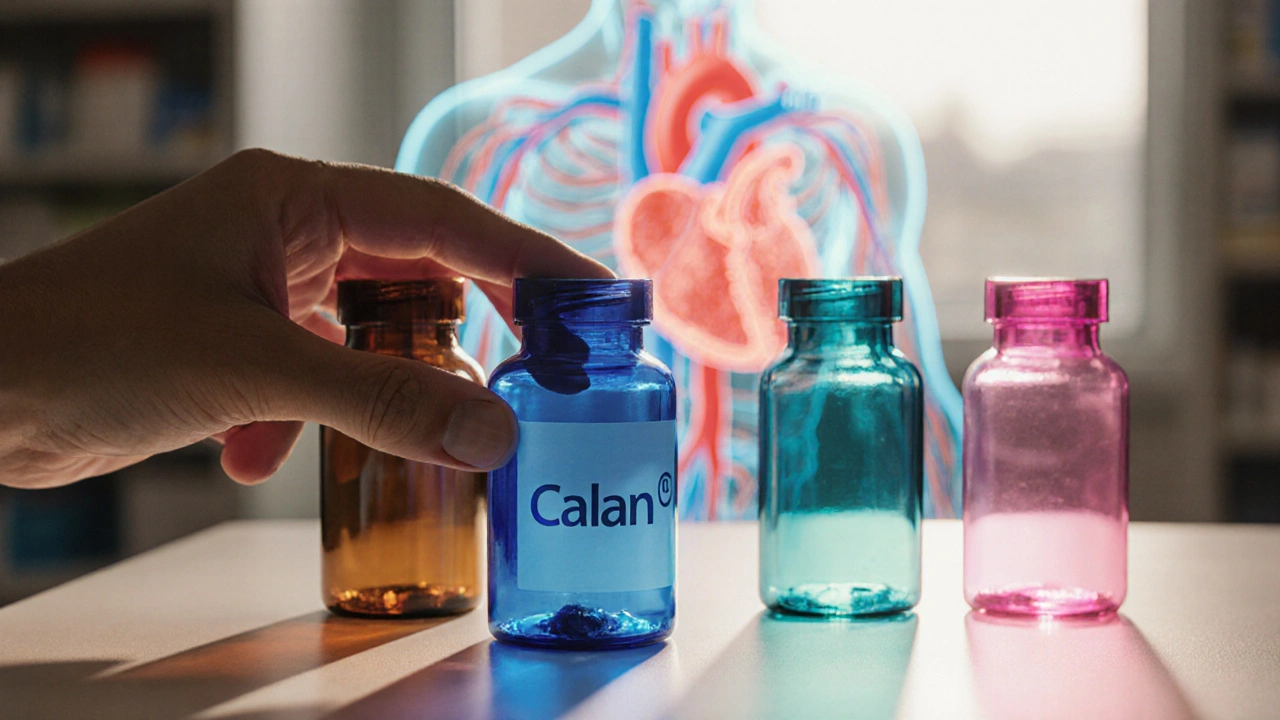Calan vs Alternatives Comparison Tool
Looking for a replacement or a better fit than Calan is the brand name for verapamil, a non‑dihydropyridine calcium‑channel blocker used for hypertension, angina and certain arrhythmias? You’re not alone. Many patients wonder whether another drug might control their blood pressure with fewer side‑effects, work better for chest pain, or simply suit their lifestyle. This guide lines up the most common alternatives, breaks down the key differences, and gives you a practical checklist to decide what fits your health goals.
Why Compare Calan with Other Drugs?
Calan does a solid job at relaxing the heart muscle and widening blood vessels, but it also carries specific downsides: constipation, slower heart rate, and potential interactions with grapefruit juice. If you’ve experienced any of those, or if your doctor mentioned a different class might be safer for your condition, it pays to understand the options before making a switch.
Decision Criteria - What Matters Most?
- Condition being treated - high blood pressure, angina, or atrial fibrillation each favor different mechanisms.
- Side‑effect profile - constipation versus swelling, fatigue versus dizziness.
- Drug interactions - some meds clash with calcium‑channel blockers; others are safer with beta blockers.
- Dosage convenience - once‑daily vs multiple doses.
- Cost and insurance coverage - generic versions can save a lot.
Keep these checkpoints in mind while you scan the table below.
Quick Comparison Table
| Drug (Generic) | Class | Typical Uses | Common Side‑effects | Dosage Frequency | Cost (AUD per month, generic) |
|---|---|---|---|---|---|
| Verapamil | Non‑dihydropyridine CCB | Hypertension, angina, SVT | Constipation, bradycardia, edema | Twice daily | $15‑$25 |
| Amlodipine | Dihydropyridine CCB | Hypertension, chronic angina | Peripheral edema, headache | Once daily | $10‑$18 |
| Diltiazem | Non‑dihydropyridine CCB | Hypertension, angina, atrial fibrillation | Swelling, dizziness, constipation | Once or twice daily | $12‑$22 |
| Nifedipine | Dihydropyridine CCB | Hypertension, Raynaud’s phenomenon | Flushing, headache, rapid heart‑rate | Once daily (extended‑release) | $8‑$14 |
| Atenolol | Beta‑blocker | Hypertension, angina, post‑MI | Fatigue, cold extremities, sleep disturbances | Once daily | $5‑$12 |
| Metoprolol | Beta‑blocker | Hypertension, angina, heart failure | Bradycardia, depression, bronchospasm (in asthmatics) | Once or twice daily | $6‑$13 |
| Lisinopril | ACE inhibitor | Hypertension, diabetic nephropathy | Cough, hyperkalemia, angioedema (rare) | Once daily | $4‑$10 |
Deep Dive into the Main Alternatives
1. Amlodipine - the once‑daily workhorse
Amlodipine belongs to the dihydropyridine subclass, which primarily relaxes peripheral vessels. Because it doesn’t slow the heart rate much, it’s often preferred for patients who experienced bradycardia on Calan. The main downside? Swelling in the ankles, especially if you’re already on a sodium‑rich diet.
2. Diltiazem - the middle ground
Diltiazem shares many properties with verapamil (both are non‑dihydropyridine agents), but it’s slightly gentler on the heart’s conduction system. It can be taken once daily in the extended‑release form, which many find easier than Calan’s twice‑daily schedule. However, it still carries a constipation risk and can interact with certain anti‑arrhythmic drugs.
3. Nifedipine - fast‑acting but flashy
Often prescribed for acute blood‑pressure spikes, extended‑release nifedipine smooths out the surge. It’s a good fallback if you need rapid control, but the flushing and fast heart‑rate can be uncomfortable for some patients.
4. Atenolol - a beta‑blocker alternative
If you’re looking to avoid calcium‑channel blockers entirely, atenolol cuts heart output and reduces renin release. It’s cheap and taken once daily, but the fatigue and cold‑hands effect can be a trade‑off.
5. Metoprolol - cardio‑focused beta blocker
Metoprolol is favored for patients with heart failure because it improves ventricular remodeling. Like atenolol, it slows the heart, so it isn’t ideal if you already have a low resting rate.
6. Lisinopril - ACE inhibitor route
Lisinopril attacks hypertension from a different angle by relaxing blood vessels via the renin‑angiotensin system. Its biggest complaint is a persistent dry cough, which can be a deal‑breaker for some.
Choosing the Right Switch - A Practical Checklist
- Identify your primary condition (e.g., hypertension vs. angina vs. atrial fibrillation).
- List any side‑effects you’re currently battling with Calan.
- Check for drug‑drug interactions with your other prescriptions.
- Consider dosing convenience - do you need a once‑daily pill?
- Compare out‑of‑pocket cost based on your pharmacy’s pricing.
- Discuss with your GP or cardiologist using the above points.
When you walk into the consultation armed with this checklist, the conversation becomes focused, and the doctor can quickly narrow down to the best alternative.
Potential Pitfalls When Switching
- Rebound hypertension: Stopping Calan abruptly can cause a temporary rise in blood pressure. Tapering or overlapping with the new drug for a few days is recommended.
- Unrecognized interactions: Some beta blockers (e.g., metoprolol) amplify the effect of calcium blockers if taken together, leading to excessive heart‑rate slowing.
- Renal function: ACE inhibitors like lisinopril need dose adjustment in reduced kidney function; your doctor should run baseline labs.
- Adherence issues: Switching to a more frequent dosing schedule can reduce compliance. Choose a once‑daily option if you’ve missed doses before.

When to Stay on Calan
Even with its quirks, Calan remains the drug of choice for certain cases:
- Patients with specific supraventricular tachycardia where verapamil’s ability to block AV‑node conduction is essential.
- Individuals who tolerate the constipation and have no significant drug interactions.
- When cost is a primary concern and a generic version is affordable.
Bottom Line
If you’ve hit a wall with side‑effects or dosing hassles, there’s a solid lineup of alternatives that can match Calan’s blood‑pressure‑lowering power with a different side‑effect profile. Use the table, checklist, and the pros‑cons breakdown to have a clear conversation with your healthcare provider. The right switch can mean smoother days, fewer bathroom trips, and better overall heart health.
Frequently Asked Questions
Can I switch from Calan to Amlodipine without a washout period?
Usually you can transition directly, but it’s safest to taper Calan over a few days while starting the Amlodipine dose. Your doctor may schedule a blood‑pressure check after 3-5 days to fine‑tune the dosage.
Is Diltiazem better for angina than Verapamil?
Both work well for angina, but Diltiazem often causes less constipation. Some cardiologists prefer it for patients who need both blood‑pressure control and angina relief.
What should I watch for if I start an ACE inhibitor after Calan?
Monitor for a dry cough, sudden swelling of the face or lips (angioedema), and check potassium levels. A baseline blood test is recommended before initiating lisinopril.
Are beta‑blockers like Atenolol safe with a history of asthma?
Atenolol is cardio‑selective, which reduces bronchial impact, but you should still discuss the risk with your doctor. Metoprolol carries a slightly higher risk of bronchospasm.
How long does it take for blood pressure to stabilize after switching drugs?
Most patients see a stable reading within 1-2 weeks, though some drugs (like ACE inhibitors) may need up to a month for full effect. Keep a log of your daily readings and share it with your prescriber.


Vani Prasanth
If you’re weighing Calan against the other options, it helps to start with what matters most to you – be it side‑effects, dosing convenience, or cost. For many patients the twice‑daily schedule of verapamil can feel cumbersome, especially when work or travel gets hectic. On the other hand, the drug’s ability to control both blood pressure and certain arrhythmias is hard to match. Look at your checklist: condition, side‑effects you’re already dealing with, and any drug interactions. Once you line those up, the alternatives become easier to compare.